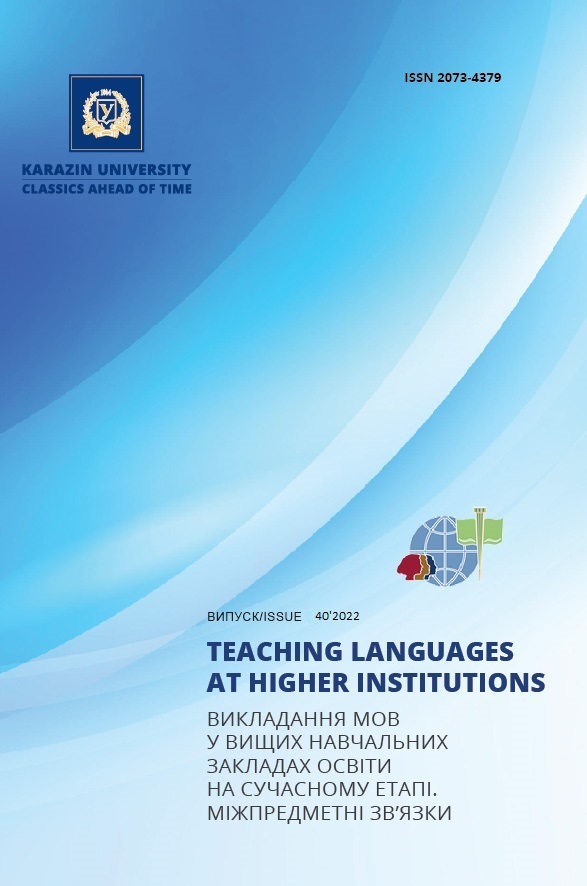Visual aids in teaching ukrainian as a foreign language
Abstract
The significantly accelerating pace of life and the increasing amount of information along with the emergence of new cognitive features of modern students have triggered the necessity to select the appropriate ways of presenting educational information. One of the ways to solve the problem is to involve various aids for visualizing knowledge, by providing language and communicative samples during the language training process of foreign students at Ukrainian higher education institutions. This article reveals the essence of the visualization concept, substantiates its use in teaching the Ukrainian language to foreign students, and covers the principles of visual aids selection such as goal orientation, functionality, complexity, and system quantization. The article provides the experimentally tested types of educational materials created with the help of visualization, such as infographics, word clouds, mental maps, memes, and wimmelbuchs. It is proved that the implementation of visual aids in the educational process also has a positive effect on the formation of cognitive interests, and improves the development of such qualities as initiative, independence, and tolerance in intercultural communication. The obtained results show that the selected types of visual aids foster the conscious acquisition of the Ukrainian language, the formation of aspect language skills, and the development of language skills as the basis of communicative competence of foreign students. The authors outline the role of Ukrainian teachers: to create such visual aids which not only complement the language materials but also reflect the socio-cultural context, i.e., form part of the Ukrainian-speaking environment. The use of the proposed set of visual aids for language training of foreign students provides ample opportunities for the formation of phonetic, lexical-grammatical, and communication skills, creates the effect of immersing a foreigner in the linguistic and cultural context visualizing each fragment of communicative interaction in brief form, and at the same time fulfills the function of a visual stimulus for communication.
Downloads
References
Abdeev, R.F. (1994). Filosofija informacionnoj civilizacii [Philosophy of information civilization]. Moscow: VLADOS [in Russian].
Bilousova L.I. and Zhyteneva, N.V. (2014). Dydaktychni aspekty vykorystannya tehnologij vizualizaciyi v navchalnomu procesi zagalnoosvitnoyi shkoly [Didactic aspects of the use of visualization technologies in the educational process of secondary school]. Informacijni tehnologiyi i zasoby navchannya [Information technologies and teaching aids]. 40 (2). Available at: https://journal.iitta.gov.ua/index.php/itlt/article/view/1017/764 [Accessed 17 Dec. 2021] [in Ukrainian].
Degtyarova, K.V. (2019). About the concept of the guidelines in the Ukrainian language as the foreign through the prism of the trends in visualization. Young scientist. 5.1 (69.1), pp. 76–80 [in Ukrainian].
Ivanenko, A.A. (2018). Vozmozhnosti primenenija vimmelbuha v metodike prepodavanija RKI [Possibilities of using Wimmelbuch in the methodology of teaching Russian as a foreign language]. Otkrytoe obrazovanie. Filologicheskij aspect [Open education. Philological aspect]. 5 (37). Available at: https://scipress.ru/philology/articles/vozmozhnosti-primeneniya-vimmelbukha-v-metodike-prepodavaniya-russkogo-yazyka-kak-inostrannogo.html [Accessed 17 Dec. 2021] [in Russian].
Kushnir, I.M. (2021). From text-centrism to discourse-centrism in teaching Ukrainian as a foreign language. Pedagogichni nauky [Pedagogical sciences]. Kherson, 96, pp. 21–27 [in Ukrainian]. DOI: https://doi.org/10.32999/ksu2413-1865/2021-96-3.
Semenovskih, T.V. (2014). Fenomen “Klipovogo myshlenija” v obrazovatelnoj vuzovskoj srede [The phenomenon of “clip thinking” in the educational university environment]. Naukovedenie [Science of Science]. 5(24). [online] Available at: https://cyberleninka.ru/article/n/fenomen-klipovogo-myshleniya-v-obrazovatelnoy-vuzovskoy-srede [Accessed 17 Dec. 2021] [in Russian].
Strutynska, O.V. (2020). Peculiarities of the modern learners generation under the conditions of the digital society development. Open educational e-environment of modern University. 9, pp. 145–160. Available at: https://openedu.kubg.edu.ua/journal/index.php/openedu /article/view/326/349 [Accessed 17 Dec. 2021] [in Ukrainian]. DOI: https://doi.org/10.28925/2414-0325.2020.9.12.
Ushakova, N.I. (2009). Uchebnik po jazyku obuchenija dlja inostrannyh studentov v rusle sovremennoj obrazovatelnoj paradigmy (Teorija i praktika sozdanija uchebnika dlja inostrannyh studentov vuzov Ukrainy) [Textbook on the language of instruction for foreign students in line with the modern educational paradigm (Theory and practice of creating a textbook for foreign students of Ukrainian universities)]. Kharkiv [in Russian].
Bolter, J.D. (2001). Writing space. Computers, hypertext, and the remediation of print. Mahwah: Lawrence Erlbaum Associates [in English].
Dobrova, V.V., Labzina, P.G., Trubitsin, K., Ageenko, N. and Gorbunova, Yu. (2017). Virtual Reality in Teaching Foreign Languages. Advances in Social Science, Education and Humanities Research (ASSEHR). 97 [in English].
Klerkx, J., Verbert, K. and Duval, E. (2014). Enhancing Learning with Visualization Techniques. Handbook of Research on Educational Communications and Technology [in English]. DOI: https://doi.org/10.1007/978-1-4614-3185-5_64.
Kolodii, O., Kovalchuk, I. and Syvak, O. (2017). The Impact of Visualization Techniques on Student’s Learning Vocabulary. International Journal of New Economics and Social Sciences, 6(2) [in English]. DOI: https://doi.org/10.5604/01.3001.0010.7649.
Umryk, M. (2013). Using active e-learning to accommodate the Net Generation of learners. E-learning & Lifelong Learning. Eugenia Smyrnova-Trybulska (ed.). University of Silesia, Studio-Noa, Katowice-Cieszyn. Vol. 5, pp. 101–113 [in English].

